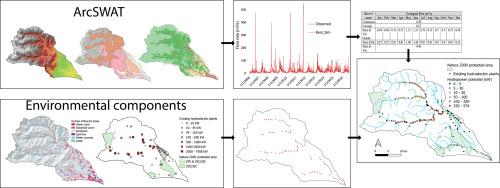基于gis的水电潜力评估方法:平衡能源生产和生态系统可持续性
Q2 Environmental Science
引用次数: 0
摘要
意大利在水力发电方面领先于欧洲,由于与当地地理和水资源一致,小型水电站占主导地位。尽管处于领先地位,但预计未来的增长将停滞不前,这突出了评估与水电潜力有关的现有发电厂的空间分布的重要性。本研究提出了一种基于gis的方法,结合SWAT水力模型,以Stura di Lanzo盆地为试验点,识别和评估不同地域背景下的潜在水电站。方法的工作流程包括根据能源需求和现有基础设施的接近程度选择感兴趣的点,通过环境法规过滤位置,使用模拟的每日排放数据计算流量可用性,以及通过分析水头值和分割河流来估计水电潜力。此外,为了实现联合国可持续发展目标6,对生态流量(EF)的释放进行了评估。在意大利,这种释放是由地区法规监管的,到目前为止,在皮埃蒙特,该法规仅确保在某些测试地点释放EF。在本研究的背景下,水电潜力的计算同时考虑了理论功率和环境兼容功率,并应用了EF概念。一项为期20年的分析(2002-2022)的结果表明,由于EF的应用,日水力发电产生了显著差异。在最后一种情况下,考虑到50%的流量超标率,选择了85个潜在站点,其中40%的站点平均年额定功率为100-250千瓦。在超过75%的情况下,确定了67个站点,其额定功率输出相似,但季节性变化增加。研究结果强调了EF分析在保护生物多样性的同时实现水电可持续发展的重要性。这种方法提供了一种具有成本效益的规划工具,适用于拥有现有或计划中的水电基础设施的地区,支持平衡生态和能源目标的战略决策。本文章由计算机程序翻译,如有差异,请以英文原文为准。

A GIS-based methodology for hydropower potential assessment: balancing energy production and ecosystem sustainability
Italy leads Europe in hydropower production, with small-scale hydropower plants dominating due to their alignment with local geography and water resources. Despite this leadership, future growth is expected to stagnate, highlighting the importance of assessing the spatial distribution of existing plants in relation to hydropower potential. This study presents a GIS-based methodology integrated with the SWAT hydraulic model in the Stura di Lanzo basin as test site to identify and evaluate potential hydropower sites in territorial diverse context.
The workflow of methodology includes selecting points of interest based on proximity to energy demand and existing infrastructure, filtering locations through environmental regulations, calculating flow availability using simulated daily discharge data, and estimating hydropower potential by analysing head values and segmenting rivers. Furthermore, to achieve Goal 6 of the United Nations Sustainable Development Goals, the release of Ecological Flow (EF) was evaluated. In Italy, this release is regulated by the Regionals Regulation, which in Piemonte, so far, only ensures the release of EF at certain test sites. In the context of this study, the hydropower potential is computed considering both a theoretical power and an environmentally compliant power, with the application of EF concept.
Results from a 20-year analysis (2002–2022) identified a significant difference in the daily hydropower production due to the application of EF. In this last case 85 potential sites were selected, considering 50% flow exceedance rate, with 40% of sites with average annual rated power of 100–250 kW. At a 75% exceedance rate, 67 sites were identified, with similar rated power outputs but increased seasonal variability. The findings emphasize the importance of EF analysis in preserving biodiversity while enabling sustainable hydropower development. This approach offers a cost-effective planning tool adaptable to regions with existing or planned hydropower infrastructure, supporting strategic decisions for balanced ecological and energy goals.
求助全文
通过发布文献求助,成功后即可免费获取论文全文。
去求助
来源期刊

Environmental Challenges
Environmental Science-Environmental Engineering
CiteScore
8.00
自引率
0.00%
发文量
249
审稿时长
8 weeks
 求助内容:
求助内容: 应助结果提醒方式:
应助结果提醒方式:


